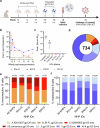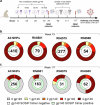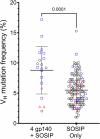Convergence and divergence of B cell responses in two HIV-1 Env immunizations in Rhesus macaques
- PMID: 40374902
- PMCID: PMC12081853
- DOI: 10.1038/s43856-025-00899-3
Convergence and divergence of B cell responses in two HIV-1 Env immunizations in Rhesus macaques
Abstract
Background: Sequential multivalent immunizations are used to counter diversity in rapidly mutating viruses. Here, we evaluated the effect of HIV-1 immunogen formats on the binding profile of memory B-cells elicited in two independent Rhesus macaque trials.
Methods: In one trial, female Rhesus macaques were immunized with a multiclade HIV-1 gp120 envelope glycoprotein (Env) cocktail and bled two weeks post final immunization. In another trial, male and female Rhesus macaques were sequentially immunized with clonally-related Env glycoproteins: Four immunogens were administered as non-stabilized gp140 Envs and the fifth as a specially stabilized gp140 Env trimer (SOSIP); animals were bled before and after SOSIP immunization. Immunogen-binding peripheral memory B-cells were sorted and cultured at limiting dilution. Culture supernatants were assessed by ELISA for binding to individual immunogens.
Results: In the first trial, 81% (591/734) of B-cells cross-react with multiple Envs and most bind to all immunogens. In the second trial, 81% (331/410) of B-cells isolated before SOSIP administration react with all non-stabilized gp140 Env immunogens and 27% also cross-react with the yet-to-be-administered SOSIP-stabilized Env. However, after SOSIP administration, SOSIP-stabilized trimer-reactive B-cells increase to 86% (219/256) but most (82%) do not cross-react with the preceding immunogens.
Conclusions: Multiclade and sequential regimens before SOSIP-stabilized Env immunization elicited B-cells that converge on shared epitopes. A change in immunogen format results in a divergent B-cell response that vastly fails to engage prior responses. Critically, B-cell priming with non-stabilized Env cannot modify the effect of the epitope immunodominance hierarchy in a SOSIP trimer. These results suggest that a change in immunogen format may cause off-target B-cell engagement, but also that B-cell repriming is possible despite pre-existing immunity.
Plain language summary
An effective vaccine against the human immunodeficiency virus-1 (HIV-1) will likely require a complex design. We studied how immune memory could be elicited and recalled by testing two vaccine strategies in rhesus macaques, animals similar to humans in immune response. In the first study, macaques received a mix of HIV-1 components, called proteins, that led to most of them being recognised by the host immune cells and generating immune memory for future exposure. In the second study, macaques were given a series of related HIV-1 proteins, ending with a specific protein called SOSIP. This led to SOSIP being recognised by a limited immune memory generated against the proteins given earlier. This highlights the importance of immune memory for repeated doses of different HIV-1 vaccines.
© 2025. This is a U.S. Government work and not under copyright protection in the US; foreign copyright protection may apply.
Conflict of interest statement
Competing interests: The authors declare no competing interests.
Figures



Update of
-
B cell immunofocusing and repriming in two HIV-1 Env immunization regimens.Res Sq [Preprint]. 2024 Apr 8:rs.3.rs-3895128. doi: 10.21203/rs.3.rs-3895128/v1. Res Sq. 2024. Update in: Commun Med (Lond). 2025 May 15;5(1):175. doi: 10.1038/s43856-025-00899-3. PMID: 38659814 Free PMC article. Updated. Preprint.
References
-
- Bedi, R., Bayless, N. L. & Glanville, J. Challenges and progress in designing broad-spectrum vaccines against rapidly mutating viruses. Annu. Rev. Biomed. Data Sci.6, 419–441 (2023). - PubMed
Grants and funding
- 1P01AI110485/U.S. Department of Health & Human Services | NIH | National Institute of Allergy and Infectious Diseases (NIAID)
- P01 AI110485/AI/NIAID NIH HHS/United States
- 1ZIAAI001342/Division of Intramural Research, National Institute of Allergy and Infectious Diseases (Division of Intramural Research of the NIAID)
- 5U19AI166916/U.S. Department of Health & Human Services | NIH | National Institute of Allergy and Infectious Diseases (NIAID)
- ZIA AI001342/ImNIH/Intramural NIH HHS/United States
LinkOut - more resources
Full Text Sources

